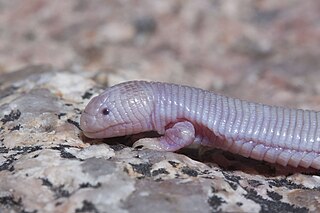
Amphisbaenia is a group of usually legless squamates, comprising over 200 extant species. Amphisbaenians are characterized by their long bodies, the reduction or loss of the limbs, and rudimentary eyes. As many species have a pink body and scales arranged in rings, they have a superficial resemblance to earthworms. While the genus Bipes retains forelimbs, all other genera are limbless. Although superficially similar to the snakes and blind lizards, recent phylogenetic studies suggest that they are most closely related to wall lizards of the family Lacertidae. Amphisbaenians are widely distributed, occurring in North America, Europe, Africa, South America, Western Asia and the Caribbean. Most species are less than 6 inches (15 cm) long.

Skinks are lizards belonging to the family Scincidae, a family in the infraorder Scincomorpha. With more than 1,500 described species across 100 different taxonomic genera, the family Scincidae is one of the most diverse families of lizards. Skinks are characterized by their smaller legs in comparison to typical lizards and are found in different habitats except arctic and subarctic regions.

Lygosoma is a genus of lizards, commonly known as supple skinks or writhing skinks, which are members of the family Scincidae. Lygosoma is the type genus of the subfamily Lygosominae. The common name, writhing skinks, refers to the way these stubby-legged animals move, snake-like but more slowly and more awkwardly.
Nessia is a genus of skinks, lizards in the family Scincidae. The genus is endemic to Sri Lanka. Species in the genus Nessia are commonly known as snake skinks.

Scelotes is a genus of small African skinks.

Plestiodon gilberti, commonly known as Gilbert's skink, is a species of heavy-bodied medium-sized lizard in the family Scincidae. The species is endemic to the southwestern United States, and grows to about 7 to 12 cm in total length.

Friedrich "Fritz" Müller was a Swiss doctor, zoologist, and herpetologist.

The Mexican mole lizard, also commonly known as the five-toed worm lizard, or simply as Bipes, is a species of amphisbaenian in the family Bipedidae. The species is endemic to the Baja California Peninsula. It is one of four species of amphisbaenians that have legs.

Brachymeles bonitae, commonly known as the stub-limbed burrowing skink or pretty short-legged skink, is a species of skink found in the Philippines. It was first described in 1839 by André Marie Constant Duméril and Gabriel Bibron. It is endemic to the Philippines.
Thwaites's skink, also known commonly as the fourtoe snakeskink, is a species of skink, a lizard in the family Scincidae. The species is endemic to the island of Sri Lanka.
Nessia burtonii, commonly known as Burton's nessia, Gray's snake skink, or the three-toed snake skink, is a species of skink, a lizard in the family Scincidae. The species is endemic to the island of Sri Lanka.
Nessia deraniyagalai, commonly known as Deraniyagala's snake skink, Deraniyagala's snakeskink, or Deraniyagala's nessia, is a species of limbless lizard in the family Scincidae. The species is endemic to the island of Sri Lanka.
Nessia didactyla, also known as the two-toed nessia and two-toed snakeskink, is a species of skink endemic to island of Sri Lanka.
The toeless snake skink, also known as the one-toed nessia, is a species of skink endemic to island of Sri Lanka.
Nessia hickanala, also known as the shark-headed snake skink and Hickanala nessia, is a species of skink endemic to island of Sri Lanka.
Nessia layardi, commonly known as Layard's snake skink or Layard's nessia, is a species of skink, a lizard in the family Scincidae. The species is endemic to the island of Sri Lanka.
Nessia sarasinorum, commonly known as Sarasins's snake skink or Müller's nessia, is a species of lizard in the family Scincidae. The species is endemic to the island of Sri Lanka.

The southern sandslider is a species of skink or Scincidae. The species is endemic to Australia and widespread across the continent, being most commonly found within sandy termite mounds. This is where they take safe refuge from the harsh Australian climate and various ground predators.
Nessia gansi, also known commonly as Gans's three-toed snake skink, is a species of lizard in the family Scincidae. The species is endemic to the island of Sri Lanka.








